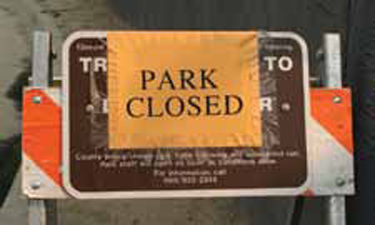 The saga of California’s troubled state park system will reach a sad milestone on June 30, 2012, when the California Department of Parks and Recreation will close a significant proportion of the 70 state parks on a closure list approved by the California legislature and governor in 2011. These parks, which range from natural area parks to historic sites to active public recreation areas, will be closed unless they have approved plans—with operating agreements in place—to keep them open beyond July 1.
The saga of California’s troubled state park system will reach a sad milestone on June 30, 2012, when the California Department of Parks and Recreation will close a significant proportion of the 70 state parks on a closure list approved by the California legislature and governor in 2011. These parks, which range from natural area parks to historic sites to active public recreation areas, will be closed unless they have approved plans—with operating agreements in place—to keep them open beyond July 1.
That it has come to this for one of the premier state park systems in the nation has puzzled and troubled parks advocates not just in California, but across the nation. This outstanding state park system of 276 state parks has been in existence for more than 100 years. The economic contribution of the systems is estimated to top $6 billion per year annually, benefitting local and regional economies from tourism, hospitality revenues, and tax receipts related to state park visitation.
This train wreck should not have come as a complete surprise to any informed observer—the state’s intractable budget deficit has gotten little better during the time its elected leadership dithered on the fate of the state parks. Crushing pension obligations, a divided General Assembly, and huge long-term debt obligations have made California’s revenue picture bleak. The most recent cut of $22 million to the department’s operating budget (resulting in the park closure list) is just the latest indignity in what could be termed death by a thousand cuts. Since 1980, the state’s share of the Department of Parks and Recreation’s General Fund support has decreased by more than 67 percent. It is no wonder that 70 parks are slated for closure, and there are deep concerns about what will happen to the rest of this once proud system.
The good news in this otherwise stark outlook is that the public has rallied around the parks like never before. Led by the California State Parks Foundation and with support of a host of local, regional, and state non-profit groups, many organizations, businesses, and individual donors have stepped up to offer funding, volunteer support, and sweat equity to save the parks.
Of the 70 parks that were approved to be closed, 16 state parks have operating agreements in place or in the pipeline to allow them to remain open. Another 19 are under negotiation, and 21 have RFPs for concession operation or camping operations. But for many of these parks the rescue plans are short-term or otherwise very minimal, and would not include natural resources stewardship or public safety.
So what happens to the rest after July 1st? The California State Park Foundation, according to President Elizabeth Goldstein, is taking the long view. “We have a three-fold strategy,” Goldstein says, “We are building capacity among nonprofits to be able to step up and take over suitable park units by creating model agreements, providing pro-bono consultants, and making technical resources available. Second, we are keeping pressure on the legislature and governor that when the state’s economy recovers, the park system should also recover. Finally, we are working to preserve the reputation and standing of California’s state park system as one of the finest in the country.” Goldstein went on to note that their concern “is not just for those parks that will close; it is for those that remain open. We must be able to gain funding to reinvest in the assets that remain open.”
While the outcomes overall are not good, the department’s listening process and creation of a “how-to” workbook for non-profits has led to a vibrant process that is leading to greater public involvement, ingenuity in creating sustainable public/private partnerships, and innovation in managing and operating the state parks. State park director Ruth Coleman said, “This is a grand experiment happening in California. We are pushing the envelope on what the limits are.”
Richard J. Dolesh is NRPA Vice President, Conservation & Parks.

